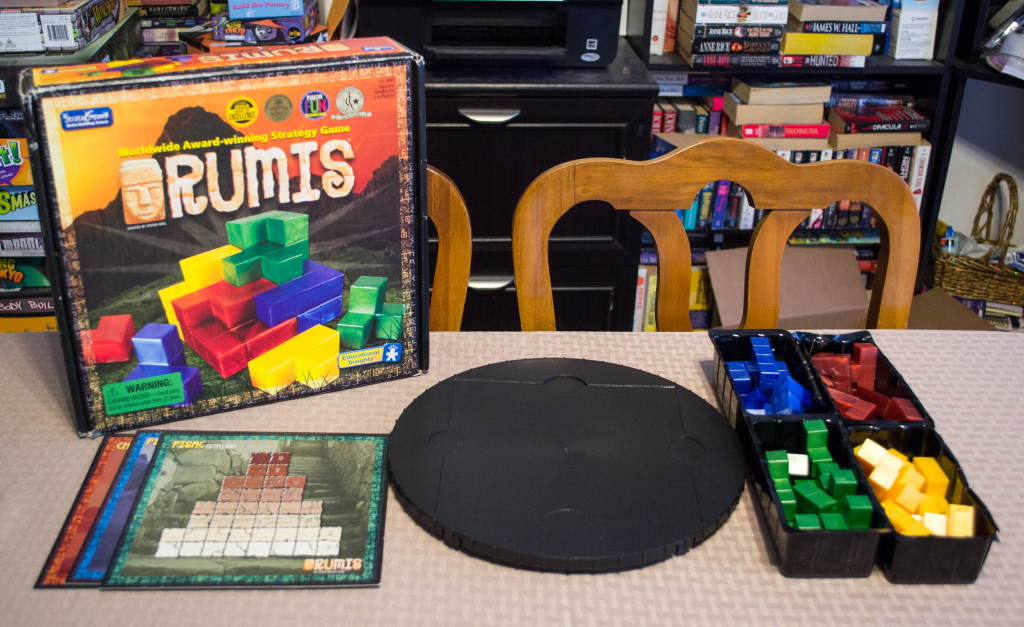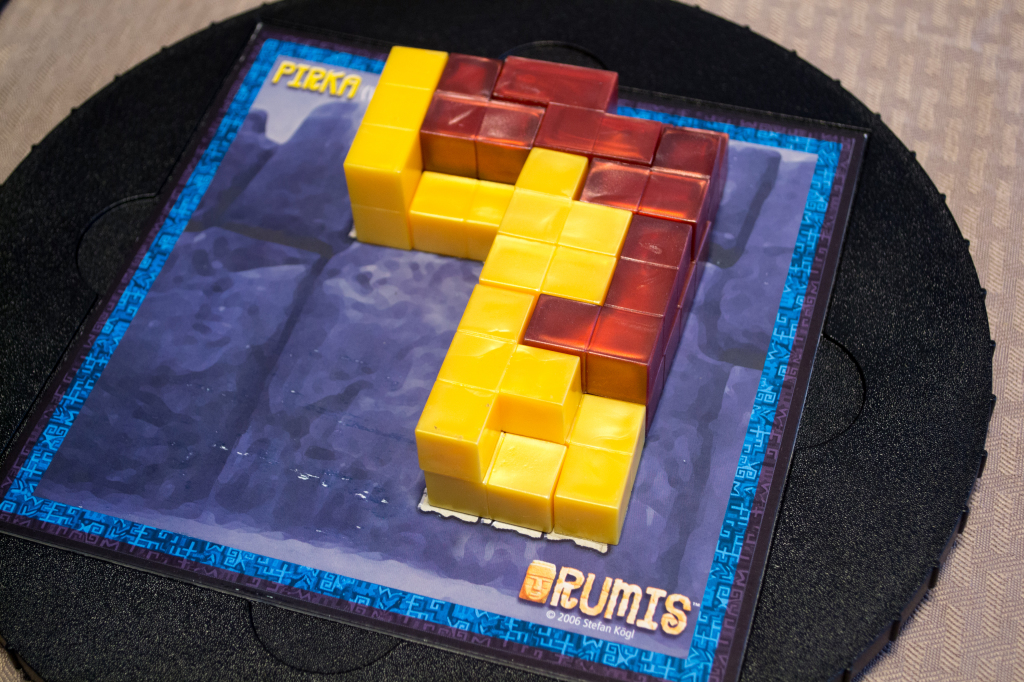It all started with a friendly game of “Blokus” when I got to thinking, “wouldn’t it be cool if there was a game that was like ‘Blokus’, but in 3D?” It turns out that there was, though I was certainly not paying sixty dollars for it. While there were listings on Amazon for “Blokus 3D” by Educational Insights, I quickly skimmed the “Customers Who Viewed This Item Also Viewed” section and came across Rumis (also by Educational Insights). It looked similar and was only fifteen bucks at the time (prices on Amazon vary since sellers set the price), so I went ahead and picked it up. I was interested to see how this particular abstract game stacked up (ba-dum-ch!), especially since I had a pretty good time with “Convert“. If you’re reading this, chances are you are too…hopefully you won’t be disappointed! “Rumis”, just as a quick FYI, means “stones” in Quechua…consider yourself educated for today, you lucky devil.
Components
Stones – There are four sets of “Tetris-like” pieces, each of a different color.
Turntable / Boards – The game includes three double-sided playing boards that fit inside the turntable. Each board represents a different scenario/architectural theme for players to try out.
Setup & Gameplay
Each player will start by choosing a set of stones (of a particular color). They’ll then decide on which of the game boards will be placed inside the turntable. The turntable itself is placed in the center of the table within easy reach of all players. It’s important that players observe the height restrictions based on the number of players and the particular board chosen. The first player is chosen at random.
For the first round of the game, players (in clockwise order) will place a stone on the game board. It must remain within the perimeter of the building plan AND not exceed the height limitation of the structure. As players place these stones, they MUST touch at least one face of any previously placed stone. After the first round, players MUST place a stone that touches the face a piece of their own color. There are a number of other placement rules, but I’ll sum them up by saying that you can’t leave gaps underneath a stone and that everyone will have to observe the height restrictions & building plan. Anyone who can’t place a stone on their turn passes.
The game ends when no one can place any more stones. Players will then look at the structure from directly overhead and count the number of faces (or individual blocks on a stone) they can see of their own color. The person with the most, wins!
The above doesn’t cover all of the rules found in the manual, but should give you an idea as to how the game is played. For more information, you can read the rulebook here:
The Review
It wasn’t difficult for me to plow into this game, namely because it is so similar to the aforementioned “Convert”. “Convert” is a bit more limiting however in that it is solely a two player game and only features a 4×4 grid. “Rumis” offers a lot more, what with three double-sided playing boards featuring various building plans. Staying within the perimeter was a challenge in some cases and really made me think about what pieces would best fit where at that current point in time. Not having played “Blokus 3D”, I couldn’t ethically compare the two…though in looking at the pictures on Amazon alone, “Rumis” seems to have a bit more theme. “Blokus 3D’s” components look pretty bland (dull gray base, etc.), for example, whereas “Rumis’s ” components capture the whole “Incan” setting pretty nicely. Obviously, some gamers may prefer one over the other for various factual and personal reasons.
“Rumis” is indeed a fun and engaging abstract block-laying game, replacing “Convert” as my go-to indulgence for when I need a quick “Tetris” fix. It encourages critical thinking like most abstract games are wont to do, which is always a plus (especially if you have kids). Games don’t take that long to play, though your mileage may vary depending on how long players in your group tend to ponder over their next move. Two player games can admittedly be too short, though there’s a variant in the manual that allows both players to use two sets of pieces each. To top that off, “Rumis” is appropriate for players of most ages making it a staple family game. My only complaint is that the pieces tend to slide around a bit, but most block-building abstract games (at least the ones I’ve played) suffer the same problem. All in all, “Rumis” is most certainly a keeper.
Final Verdict: 8/10
—


